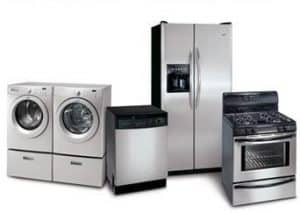Moving Large Appliances

Despite being heavy and durable, major home appliances are actually relatively fragile items because of all of their delicate inner workings. Moving companies will insist that all major appliances are prepared before they arrive and some may offer a professional service that will prepare major appliances for you for a fee. While it may seem pretty simple to prepare your appliances for moving, if not done correctly, you may find that it does not work properly at your new residence.
When preparing large appliances for your move, there are special precautions you need to take. You should consult the owner’s manual and either prepare the appliance for moving yourself or hire a professional to do it for you. Pre-move preparation is required for many major appliances. All appliances must be disconnected and dry before loading.
Keep in mind that even if you are hiring a professional mover they are movers not handy men. Movers often can not allowed to discconnect or reconnect your appliances by their insurance company. If they do, expect an additional charge to be added to your bill.
To prepare your large kitchen appliances such as the fridge, stove, and dishwater for a move, first empty them all of shelves and racks. Pack up these accessories separately so they don’t shift inside your appliances during the move. For all appliances, unplug and secure the plug to the back using packing tape. Don’t let cords dangle or come loose. Tape all doors and lids shut.
Front Loading Washers and dryers need special handling. It’s a good idea to consult the owner’s manual or contact the manufacturer. Remove all hoses and pack separately in a box. For the washer, you’ll need to secure the drum. If you don’t have the manufacturers guidelines, you can purchase a washer kit with a manual that provides instructions on how to secure the tub by tightening down the tub using screws. If you prefer not to do it yourself, there are many third party service providers. If you are moving a gas dryer, the appliance should be disconnected and the gas line capped off by a qualified technician. The driver and the crew members are not qualified to perform this service.
The refrigerator should be emptied, cleaned and unplugged at least 24 hours prior to the move. Dispose of all perishables. Once the freezer unit has defrosted, thoroughly clean and dry all surfaces and removable containers to prevent mildew and odors from forming. Remove all racks or secure them so they don’t shift during the move. If your unit has an ice maker, disconnect the waterline and make sure it’s completely drained. At destination, do not operate the refrigerator for at least 24 hours after delivery. This allows the oil time to settle, preventing possible damage to the compressor.
The stove should be thoroughly cleaned inside and out with the racks removed or securely fastened. If you have a gas stove, make sure the gas is turned off before you start disconnecting the line and be very careful. Gas lines can be fragile and need special handling. If you’re unsure, call your gas company and ask for help. Tape down the knobs and elements to ensure no parts are lost during the move. If you are moving a gas range, it must be disconnected prior to moving day by a qualified service technician. The gas line must be properly secured also. When arriving at your new residence with your gas range, you will need a qualified gas installer to check your gas supply, connect the gas line, seal any openings, light the pilot and handle any other hook-up requirements.
Your appliances were not designed to be used as shipping containers. The weight of food or other items stored inside during the move can damage the interior and perhaps even disable its proper function at your new home.
Remember to prepare your large appliances for the move prior to the movers arrival and if needed call in a professional.
